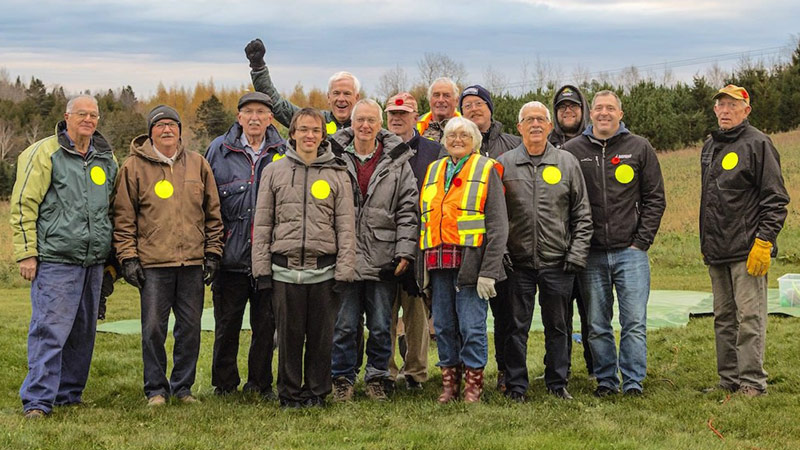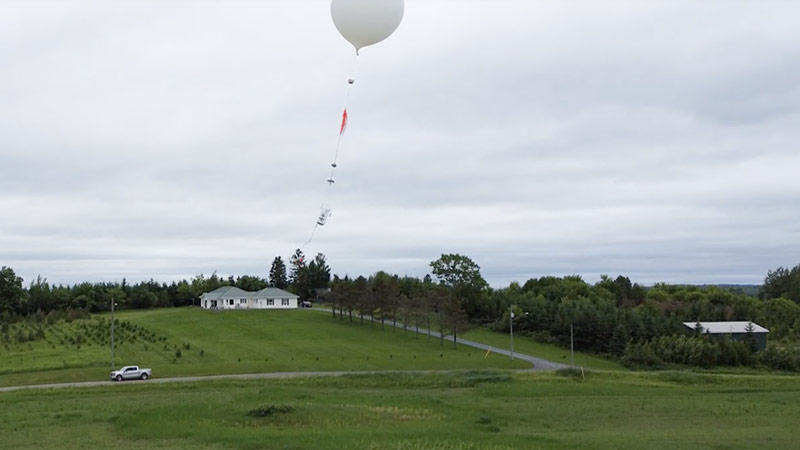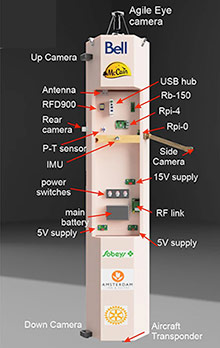Balloon, telescope provide view of the eclipse above the clouds
Author: Kelly Anderson
Posted on Mar 21, 2024
Category: UNB Fredericton

A total solar eclipse is a rare and awe-inspiring opportunity to marvel at nature and the cosmos. But for many University of New Brunswick (UNB) students and alumni, the celestial event that happens in central New Brunswick on April 8 will be even more special.
That’s because they have been part of a years-long project to launch a high-altitude balloon with a solar telescope to capture the event, making live images of the eclipse available to watchers on the ground even if there is cloud cover that day.
The 185km eclipse shadow will sweep into New Brunswick near Florenceville-Bristol, which is perfectly situated at nearly the exact centre of the path of totality, making it the ideal spot to view the eclipse. Resident David Hunter, a retired medical physicist and astronomy buff, knew this was an opportunity he couldn’t let pass.
“It’s very rare to be in the path of totality for a solar eclipse, and since April is typically cloudy, I didn’t want to miss it. The balloon and the payload it carries - an intricate grouping of four computers, six cameras, two tracking devices, a radio transmitter and instrumental gear - is expected to transmit live, magnified, telescopic images and video back to earth for a live feed of the eclipse no matter what the weather conditions,” he explains.
“The payload system has a sophisticated cutdown unit which can first detach the payload from the balloon, and then seconds later deflate the balloon. The payload has a parachute which brings it to ground with a soft landing.”
Hunter, a member of the Royal Astronomical Society of Canada New Brunswick Centre, began developing plans for the unique project in 2019 and quickly assembled a team of scientists, engineers and other volunteers to help with what has turned into a very complicated and sophisticated project. That team includes his brother, Lawson Hunter (BSc'67, LLB'70, LLD'11), as well as 12 UNB engineering students and numerous UNB alumni.
“A novel piece of the project was developing a small telescope system capable of dynamically pointing to the Sun and Moon,” David describes. “In high-altitude balloon projects to date, non-magnifying cameras randomly point to the Sun, the Moon or the horizon with no directional control. We need it to be reliable to capture this rare event.”
Engineering students play important role

That’s where UNB engineering students came in.
For the past three years, multidisciplinary teams of mechanical and electrical engineering students have worked on the project as part of their capstone design course in their final year of the undergraduate engineering degree at UNB. This year’s team has contributed to very specific challenges the project was facing.
Mechanical engineering student Olivia DeMerchant explains.
“My mechanical engineering teammate, Zoe Devries, and I have been working on an automatic anti-rotational mechanism for the telescope. One of the major issues encountered is that when the balloon is launched, it rotates and is moved by the wind,” she says.
“A great deal of effort has been expended on developing a device: the agile eye – a solar tracking system that includes the telescope lens. The agile eye keeps the sun shining into the telescope even at relatively high rotation rates. However, residual motion occurs which causes some distortion of the image. So, reducing the rate of rotation is important. We’ve been developing a mechanism to decrease the rotation of the payload. It’s basically a weighted wheel – a reaction wheel – that spins in a direction opposite to the payload rotation direction to bring rotation to a stop in a controlled way.”
Electrical engineering student Matt Snell adds, “My part has been working on the agile eye to use a fisheye lens to capture the eclipse, process and communicate it back to the motor system. Zach Demerson, my electrical engineering teammate, worked on a way to auto focus the lens when in the stratosphere.”
Troy Lavigne (BScEng’92, MScEng’11), a project engineer with UNB’s faculty of engineering, and Andy Simoneau, chair of the department of mechanical engineering at UNB, oversee the students in capstone design course.
“Students who work with external clients on real-world projects like this gain so much, but this unique and extraordinary opportunity has been tremendous,” says Lavigne. “The students are mentored by David and UNB alum Tom Sisk (BScEng’82), both of whom are incredibly knowledgeable and whose excitement is infectious. The students have had the opportunity to work with technology they never would have used otherwise, and they get to apply the theory learned in the classroom to design and testing in a real-life situation.”
Sisk was pulled into the project by David Hunter early on because of his vast experience in engineering design, but also because he is one of the few people in the region who has put a small payload into the atmosphere on a balloon. The retired engineer and consultant had volunteered at Bliss Carmen Middle School in Fredericton and helped students put a helium balloon with a camera into space to measure temperatures and other scientific data. When he met Hunter, Sisk says he became “the balloon guy” for the project.
“We’ve tried to make the payload as small and light as possible, but as the project kept getting bigger and heavier, we realized we needed to get regulatory approval,” Sisk explains.
“Transport Canada is now involved and the balloon will carry an aircraft transponder and be supervised by a commercial pilot who will be touch with air traffic control in Moncton and Boston the whole time the balloon is in the air. The whole assembly is now almost 8kg, which is much heavier than a weather balloon. We’ve done three tests to date and have learned a lot on each one. We now feel pretty comfortable that the mission on eclipse day will go as planned.”
Sisk and Hunter say that having UNB students involved in the project has been integral to its success.

“I wanted to engage students, both for critical resources and also to provide a unique learning opportunity,” David says. “The first groups of students worked on the beginning models of the payload and we’ve been getting more and more detailed and sophisticated from there.”
Ethan Garnier was a software engineering student involved in year two of the design.
“I was forced to step outside of my comfort zone on this project. The problems we were tasked with solving weren’t cookie-cutter, so we couldn’t simply look up the answers,” he says. “We failed a lot, but through that we were able to learn and design solutions that worked. The entire process was extremely beneficial to my growth as an engineer and being part of this project has truly been a once-in-a-lifetime opportunity.”
Since finishing course work on the project in April 2023, Garnier has continued to consult on software related issues and has helped on launch days. “Being part of this is just so exciting and such a privilege.”
Indeed, not many students – or anyone – can say they’ve worked on projects above 99 per cent of the atmosphere. Lawson Hunter, who has been a big part of generating the funding, approvals and partnerships to make the project a success, says that “this is the only citizen-led project of its kind outside of NASA.”
The eclipse and balloon launch certainly promises to be a moment of wonder – one that anyone involved or witnessing will not soon forget. The last time there was a total eclipse of the sun in central New Brunswick was in the year 932 and the next will not be until 2079.
To view the eclipse and the balloon launch, which happens at 3:30 p.m. on April 8, consider making your way to Florenceville-Bristol, where livestream viewing locations will be open and where Canadian astronaut Chris Hadfield, along with renowned New Brunswick comedian James Mullinger,will be watching the main event and speaking afterward.
Follow the solar balloon project on Facebook.
Banner photo, Ground Station team, left to right: James Tompkins, Chip Hunter, Tom Sisk, Stephen Downward, Chris Docherty, David Hunter, Geoffrey Foster, James Blackie, Cecile Blackie, Sandy Hunter, Lawson Hunter, Makenzie Dixon, Jason Hovey and Gordon Hunter.
